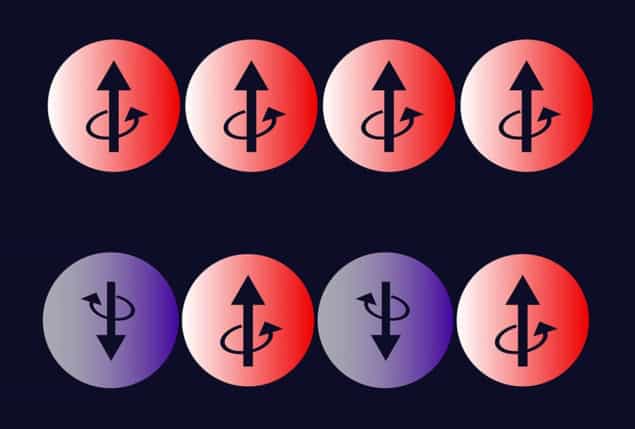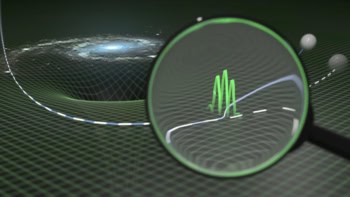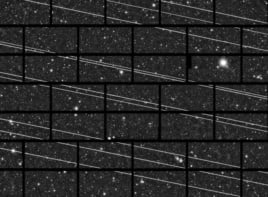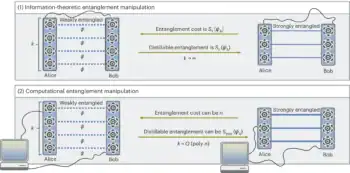
A new experiment to determine whether or not gravity is affected by the act of measurement has been proposed by theoretical physicists in the UK, India and the Netherlands. The experiment is similar to one outlined by the same group in 2017 to test whether or not two masses could become quantum-mechanically entangled by gravity, but the latest version could potentially be easier to perform.
An important outstanding challenge in modern theoretical physics is how to reconcile Einstein’s general theory of relativity – which describes gravity – with quantum theory, which describes just about everything else in physics.
“You can quantize gravity” explains Daniel Carney of the Lawrence Berkeley National Laboratory in California, who was not involved in this latest research. However, he adds, “Gravitational wave detection is extremely quantum mechanical…[Gravity is] a normal quantum field theory and it works fine: it just predicts its own breakdown near black hole singularities and the Big Bang and things like that.”
Multiple experimental groups around the world seek to test whether the gravitational field can exist in non-classical states that would be fundamentally inconsistent with general relativity. If it could not, it would suggest that the reason quantum gravity breaks down at high energies is that gravity was not a quantum field. Performing these tests, however, is extraordinarily difficult because it requires objects that are both small enough to be detectably affected by the laws of quantum mechanics and yet massive enough for their gravitation to be measured.
Hypothetical analogy
Now, Sougato Bose of University College London and colleagues have proposed a test to determine whether or not the quantum state of a massive particle is affected by the detection of its mass. The measurement postulate in quantum mechanics says that it should be affected. Bose offers a hypothetical analogy: a photon passes through an interferometer, splitting its quantum wavefunction into two paths. Both paths interact equally with a mass in a delocalized superposition state. When the paths recombine, the output photon always emerges from the same port of the interferometer. If, however, the position of the mass is detected using another mass, the superposition collapses, the photon wavefuntion no longer interacts equally with the mass along each arm and the photon may consequently emerge from the other port.
However, this conceptually simple test is experimentally impracticable. For a mass to exert a gravitational field sufficient for another mass to detect it, it needs to be at least 10-14 kg – about a micron in size: “A micron-sized mass does not go into a quantum superposition, because a beamsplitter is a like a potential barrier, and a large mass doesn’t tunnel across a barrier of sufficient height,” explains Bose.
The solution to this problem, according to Bose and colleagues, is to use a small diamond crystal containing a single nitrogen vacancy centre – which contains a quantum spin. At the beginning of the experiment, a microwave pulse would initialize the vacancy into a spin superposition. The crystal would then pass through a Stern–Gerlach interferometer, where it would experience a magnetic field gradient.
Nitrogen vacancy centres are magnetic, so opposite spins would be deflected in opposite directions by the magnetic field gradient. Crystals with spins in superposition states would be deflected both ways simultaneously. The spins could then be inverted using another microwave pulse, causing the crystals to recombine with themselves without providing any information about which path they had taken. However, if a second interferometer were placed close enough to detect the gravitational field produced by the first mass, it would collapse the superposition, providing “which path” information and affecting the result measured by the first interferometer.
Stern–Gerlach interferometers
In 2017, Bose and colleagues proposed a similar setup to test whether or not the gravitational attraction between two masses could lead to quantum entanglement of spins in two Stern–Gerlach interferometers. However, Bose argues the new test could be easier to perform, as it would not require measurement of both spins simultaneously – simply for a second interferometer to perform some kind of gravitational detection of the first mass’s position. “If you see a difference, then you can immediately conclude that an update on a quantum measurement is happening.”

Century-old photoelectric effect inspires a new search for quantum gravity
Moreover, Bose says that the inevitable invasiveness of a measurement is a different postulate of quantum mechanics from the formation of quantum entanglement between the two particles as a result of their interaction. In a hypothetical theory going beyond both quantum mechanics and general relativity, one of them could hold but not the other. The researchers are now investigating potential ways to implement their proposal in practice – something Bose predicts will take at least 15 years.
Carney sees some merit in the proposal. “I do like the one-sided test nature of things like this, and they are, in some sense, easier to execute,” he says; “but the reason these things are so hard is that I need to take a small system and measure its gravitational field, and this does not avoid that problem at all.”
A paper describing the research has been accepted for publication in Physical Review Letters and is available on the arXiv pre-print server.



